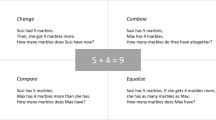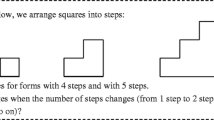Abstract
Solving word problems is challenging in elementary schools, both for the teacher in teaching students to solve word problems and for the student in learning to solve them. This paper examines how the ideas of learning trajectory and variation pedagogy could be integrated as an instructional principle for teaching this content in the context of solving additive comparison problems. Based on research literature, a learning trajectory for solving additive comparison problems was identified. Informed by variation pedagogy and using a lesson study approach, a research team explored how to teach solving comparison word problems based on this learning trajectory. Data included lesson plans, videotaped research lessons, students’ pre- and post-tests, and students’ interviews. A fine-grained analysis of the data demonstrated that the lessons unfolded through exploration of a series of deliberate tasks along the learning trajectory, focusing on the structure of comparison problems and targeted at objects of learning. Purposefully constructed patterns of variation and invariance provided students with necessary conditions to discern and experience the objects of learning. Students were actively engaged in making sense of comparison problems and articulating their thinking using multiple representations. While the post-test and interview data show students’ understanding of key aspects of solving additive comparison problems to be at various levels, students’ gains in overall performance from pre- to post-test were statistically significant. Implications for teaching comparison word problems are discussed.


Similar content being viewed by others
Notes
The Chinese names of Yangyang (YY), Lele(LL), Xiaohong (XH), Xiaoliang (XL) will be represented as their acronym YY, LL, XH and XL hereafter in this article.
References
Baroody, A. J., & Purpura, D. J. (2017). Early number and operations: Whole numbers. In J. Cai (Ed.), Compendium for research in mathematics education (pp. 308–354). Reston: National Council of Teachers of Mathematics.
Briars, D. J., & Larkin, J. H. (1984). An integrated model of skills in solving elementary word problems. Cognition and Instruction, 1, 245–296.
Cai, J., & Lester, F. A. (2005). Solution and pedagogical representations in Chinese and U.S. mathematics classroom. Journal of Mathematical Behavior, 24(3–4), 221–237.
Clements, D. H., & Sarama, J. (2004). Learning trajectories in mathematics education. Mathematical Thinking and Learning, 6(2), 81–89.
Clements, D. H., Sarama, J., Spitler, M. E., Lange, A. A., & Wolfe, C. B. (2011). Mathematics learned by young children in an intervention based on learning trajectories: A large-scale cluster randomized trial. Journal for Research in Mathematics Education, 42(2), 127–166.
Common Core State Standards Initiative (CCSSI). (2010). Common core state standards for mathematics, National Governors Association and the Council of Chief State School Officers, Washington, DC. Retrieved at: http://www.corestandards.org/Math/Practice. Accessed 9 Aug 2018.
Fuson, K. C. (1992). Research on whole number addition and subtraction. In D. Grouws (Ed.), Handbook of research on mathematics teaching and learning (pp. 243–275). New York: Macmillan Publishing.
Fuson, K. C., Carroll, W. M., & Landis, J. (1996). Levels in conceptualization and solving addition and subtraction compare word problems. Cognition and Instruction, 14(3), 345–371.
Fuson, K. C., & Murata, A. (2007). Integrating NRC principles and the NCTM process standards to form a class learning path model that individualizes within whole-class activities. National Council of Supervisors of Mathematics Journal of Mathematics Education Leadership, 10(1), 72–91.
Fuson, K. C., Murata, A., & Abrahamson, D. (2014). Using learning path research to balance mathematics education: Teaching/learning for understanding and fluency. In R. Cohen, Kadosh & A. Dowker (Eds.), Oxford handbook of numerical cognition (pp. 1036–1054). Oxford: Oxford University Press.
Gu, F., Huang, R., & Gu, L. (2017). Practice and development of teaching through variation in China. In R. Huang & Y. Li (Eds.), Teaching and learning through variations (pp. 13–42). Rotterdam: Sense.
Gu, L., Huang, R., & Marton, F. (2004). Teaching with variation: An effective way of mathematics teaching in China. In L. Fan, N. Y. Wong, J. Cai & S. Li (Eds.), How Chinese learn mathematics: Perspectives from insiders (pp. 309–348). Singapore: World Scientific.
Hegarty, M., Mayer, R. E., & Monk, C. A. (1995). Comprehension of arithmetic word problems: A comparison of successful and unsuccessful problem-solvers. Journal of Educational Psychology, 87(1), 18–32.
Huang, R., Gong, Z., & Han, X. (2016). Implementing mathematics teaching that promotes students’ understanding through theory-driven lesson study. ZDM Mathematics Education, 48, 425–439.
Huang, R., & Han, X. (2015). Developing mathematics teachers’ competence through parallel lesson study. International Journal for Lesson and Learning Studies, 4(2), 100–117.
Huang, R., Kimmins, D., Winters, J., Douglas, D., & Tessema, A. (2017). Teacher learning through perfecting a lesson through Chinese lesson study. Paper presented at PME-NA 39 in Indianapolis, Indiana, USA.
Lesh, R., Post, T., & Behr, M. (1987). Representations and translation among representations in mathematical learning and problem solving. In C. Janvier (Ed.), Problem of representation in teaching and learning of mathematics learning (pp. 3–40). Hilldale: Erlbaum.
Lewis, A. B. (1989). Training students to represent arithmetic word problems. Journal of Educational Psychology, 81, 521–531.
Lewis, A. B., & Mayer, R. E. (1987). Students’ miscomprehension of relational statements in arithmetic word problems. Journal of Educational Psychology, 79, 363–371.
Lewis, C. (2016). How does lesson study improve mathematics instruction? ZDM Mathematics Education, 48(4), 571–580.
Li, X. (1992). On integrity and development of children’s addition and subtraction cognitive structure (in Chinese). Psychological Development and Education, 8(1), 9–16.
Lo, M. L., & Marton, F. (2012). Toward a science of the art of teaching: Using variation theory as a guiding principle of pedagogical design. International Journal for Lesson and Learning Studies, 1(1), 7–22.
Marton, F. (2015). Necessary conditions of learning. New York: Routledge.
Marton, F., & Pang, M. F. (2006). On some necessary conditions of learning. The Journal of the Learning Sciences, 15, 193–220.
Ministry of Education, P. R. China (MoE). (2011). Mathematics curriculum standards for compulsory education (grades 1–9) (in Chinese). Beijing: Beijing Normal University Press.
Múñez, D., Qrrantia, J., & Rosales, J. (2013). The effect of external representations on compare word problems: Supporting mental model construction. The Journal of Experimental Education, 81(3), 337–355.
Mwangi, W., & Sweller, J. (1998). Learning to solve compare word problems: The effect of example format and generating self-explanations. Cognition and Instruction, 16(2), 173–199.
National Council of Teachers of Mathematics (NCTM). (2000). Principles and standards for school mathematics. Reston: National Council of Teachers of Mathematics (NCTM).
Nunes, T., Dorneles, B. V., Lin, P. J., & Rathgeb-Schnierer, E. (2016). Teaching and learning about whole numbers in primary school. Switzerland: Springer.
Pang, M. F., Bao, J. S., & Ki, W. W. (2017). “Bianshi” and the variation theory of learning: Illustrating two frameworks of variation and invariance in the teaching of mathematics. In R. Huang & Y. Li (Eds.), Teaching and learning through variations (pp. 43–68). Rotterdam: Sense.
Pape, S. J. (2003). Compare word problems: Consistency hypothesis revisited. Contemporary Educational Psychology, 28, 396–421.
Riley, M. S., & Greeno, J. G. (1988). Developmental analysis of understanding language about quantities and of solving problems. Cognition and Instruction, 5, 49.
Simon, M. A. (1995). Prospective elementary teachers’ knowledge of division. Journal for Research in Mathematics Education, 24, 233–254.
Stern, E. (1993). What makes certain arithmetic word problems involving the comparison of sets so difficult for children? Journal of Educational Psychology, 85, 7–23.
Sun, X. (2011). “Variation problems” and their roles in the topic of fraction division in Chinese mathematics textbook examples. Educational Studies in Mathematics, 76, 65–85.
Sztajn, P., Confrey, J., Wilson, P. H., & Edgington, C. (2012). Learning trajectory based instruction: Toward a theory of teaching. Educational Researcher, 41, 147–156.
Van de Walle, J. A., Karp, K. S., & Bay-Williams, J. M. (2016). Elementary and middle school mathematics: Teaching developmentally. Boston: Person Education Inc. (9 edition).
Verschaffel, L. (1994). Using retelling data to study elementary school children’s representations and solutions of compare problems. Journal for Research in Mathematics Education, 25, 141–165.
Verschaffel, L., De Corte, E., & Pauwels, A. (1992). Solving compare problems: An eye-movement test of Lewis and Mayer’s consistency hypothesis. Journal of Educational Psychology, 84(1), 85–94.
Verschaffel, L., Greer, B., & De Corte, E. (2007). Whole number concepts and operations. In F. K. Lester (Ed.), Second handbook of research on mathematics teaching and learning (pp. 557–628). Reston: NCTM.
Wang, J. (2013). Mathematics education in China: Tradition and reality. Singapore: Galeasia Cengage Learning.
Wilson, P. H., Mojica, G. F., & Confrey, J. (2013). Learning trajectories in teacher education: Supporting teachers’ understandings of students’ mathematical thinking. The Journal of Mathematical Behavior, 32(2), 103–121.
Wilson, P. H., Sztajn, P., Edgington, C., & Myers, M. (2015). Teachers’ uses of a learning trajectory in student-centered instructional practices. Journal of Teacher Education, 66(3), 227–244.
Yang, Y., & Ricks, T. E. (2013). How crucial incidents analysis support Chinese lesson study. International Journal for Lesson and Learning Studies, 1(1), 41–48.
Zhou, Z., & Peverly, S. T. (2005). Teaching addition and subtraction to first graders: A Chinese perspective. Psychology in the Schools, 42, 259–272.
Acknowledgements
We extend our thanks for the strong support from the participating school, Qiaotou no. 2 Elementary School of Yongjia County, City of Wenzhou, and especially to teaching research specialist Ms. Yuxiao Nan and mathematics teacher Jing Huang for their intellectual contribution to improving the design and teaching of the comparison word problem lessons.
Author information
Authors and Affiliations
Corresponding author
Rights and permissions
About this article
Cite this article
Huang, R., Zhang, Q., Chang, Yp. et al. Developing students’ ability to solve word problems through learning trajectory-based and variation task-informed instruction. ZDM Mathematics Education 51, 169–181 (2019). https://doi.org/10.1007/s11858-018-0983-8
Accepted:
Published:
Issue Date:
DOI: https://doi.org/10.1007/s11858-018-0983-8




